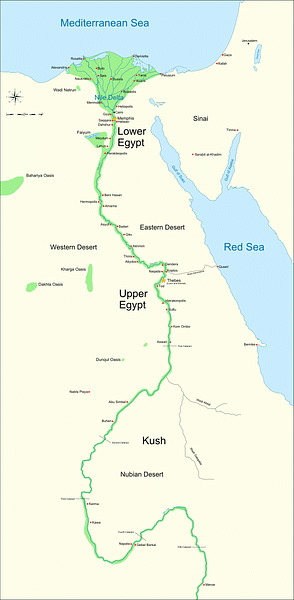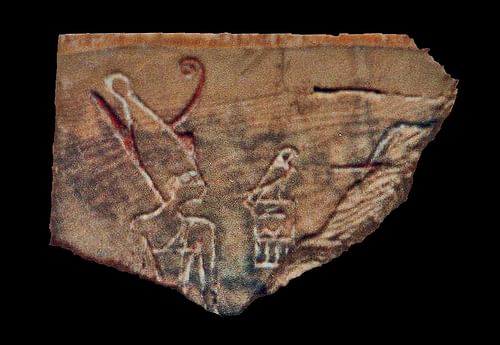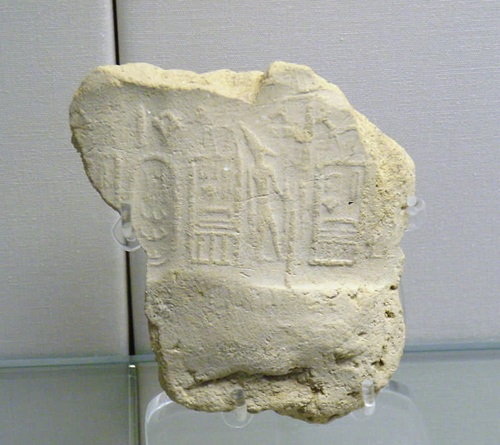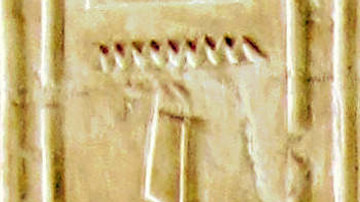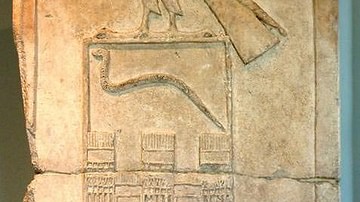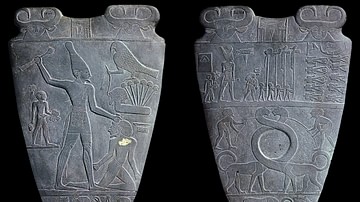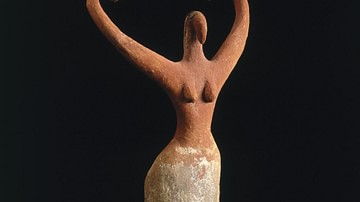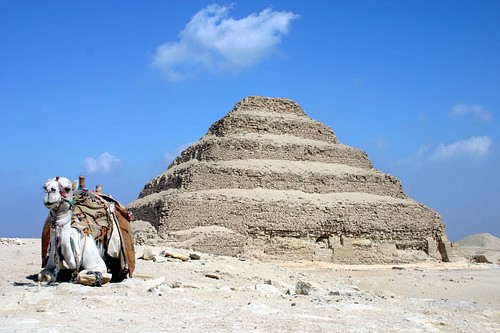
The Early Dynastic Period In Egypt (c. 3150 - c. 2613 BCE) is the beginning of the historical era of the country during which the regions of Upper Egypt (south) and Lower Egypt (north) were united as one country under a centralized government.
During this period the divine rule of the kings began and a recognizable Egyptian culture, including the development of writing, arts, and sciences developed. The title `pharaoh' was not used during this period; rulers were referred to as `kings' and addressed as `your majesty'. The title of `pharaoh' was not used until the period of the New Kingdom (c. 1570 - c. 1069 BCE) when the word pero (also per-a-a) came into use to designate the royal residence and meant `Great House' in reference to the king's palace.
This era followed the Predynastic Period in ancient Egypt (c. 6000 - c. 3150 BCE) and was followed by the period known as the Old Kingdom (c. 2613 - 2181 BCE). While these dates are not arbitrary they should not be understood as any kind of demarcation ending one era and beginning another. They are used to help clarify the long history of Egypt by dividing its story into sections of cohesive development.
The line between some periods in ancient Egyptian history does seem quite clear while, with others (such as that between the Predynastic and Early Dynastic periods), it is blurred. Dates should be understood to be approximations the further back in time one travels in Egyptian history. This same paradigm, however, should also be applied to all of Egyptian history as the ancient Egyptians themselves did not record their history according to these terms and demarcations; all of these are modern constructs.
Egypt's Unification & First King
According to the chronology of Manetho (3rd century BCE), the first king of Egypt was Menes, a king of Upper Egypt possibly from the city of Thinis (or Hierkanopolis), who overcame the other city states around him and then went on to conquer Lower Egypt. This king's name is known primarily through written records such as Manetho's chronology and the Turin King List, however, it is not corroborated by any extensive archeological evidence and scholars now believe the first king may have been a man named Narmer who peacefully united Upper and Lower Egypt at some point c. 3150 BCE.
This claim is contested owing to the Narmer Palette (an ancient inscribed slab) which depicts a king, positively identified as Narmer, as a military figure conquering a region which is clearly Lower Egypt. Historian Marc Van de Mieroop comments on this:
That Egypt was created through military means is a basic concept expressed in the art of the period. A sizeable set of stone objects, including cermonial mace-heads and palettes, contain scenes of war and fighting between men, between animals, and between men and animals.Whereas in the past Egyptologists read the scenes of war literally as records of actual events, today they prefer to see them as stereotypical statements of kingship and the king's legitimacy. (33)
This new method of interpreting ancient inscriptions, however valuable some may consider it, does not mean such interpretations are accurate. The argument against such interpretations asks why, if these inscriptions are to be taken symbolically, others of later periods - such as those of Rameses the Great at the Battle of Kadesh - continue to be read literally as historical record. Van de Mieroop comments further, stating, "This new approach makes it impossible to date the unification of Egypt or attribute it to a specific individual on the basis of these representations" (33-34) but notes that, whatever the case regarding the first ruler, "the art of the period shows that the Egyptians linked unification with conflict" (34). Scholar Douglas J. Brewer, on the other hand, does not see any problem in regarding the inscriptions symbolically. The name `Menes" means "He who endures" and could possibly be a title, not a personal name, in which case there is no difficulty in identifying the first king as Narmer `who endured'.
The name `Menes' has also been found on an ivory inscription from Naqada associated with Hor-Aha, which could mean the title was passed down or that Hor-Aha was the first king. Brewer notes that these ancient inscriptions, such as the Narmer Palette, perpetuate "a culturally accepted scenario and, therefore, should perhaps be regarded as a monument commemorating an achieved state of unity rather than depicting the process of unification itself" (141). To scholars such as Brewer, the means by which unification came about are not as important as the fact of unification itself. The details of the event, like those of any nation's origins, may have been largely embellished upon by later writers. Brewer writes:
Menes probably never existed, at least as the individual responsible for all the attributed feats. Rather he is most likely a compilation of real-life individuals whose deeds were recorded through oral tradition and identified as the work of a single person, thereby creating a central hero figure for Egypt's unification. Like the personalities of the Bible, Menes was part fiction, part truth, and the years have masked the borderline, creating a legend of unification. (142)
Unification, Brewer (and others) claim was "most likely a slow process stimulated by economic growth" (142). Upper Egypt seems to have been more prosperous and their wealth enabled them to systematically absorb the lands of lower Egypt over time as they found they needed more resources for their population and for trade. Whether the king who united the country was Narmer or someone of another name, this king lay the foundation for the rise of one of the greatest civilizations of the ancient world.
Egypt's First Dynasty
The First Dynasty of Egypt (c. 3150 - c. 2890 BCE) was founded by Menes/Narmer after the unification of the country. The great Egyptologist Flinders Petrie (l. 1853-1942 CE) accepted Narmer as the first king of the first dynasty claiming that the two names designated one man. Flinders Petrie, and others following him, claim that whether Narmer united Egypt by force is considered irrelevant in that it is almost certain he had to maintain the kingdom through military means and this would account for his depiction in inscriptions such as the Narmer Palette.
Narmer (probably from Thinis) married the princess Neithhotep of Naqada in an alliance to strengthen ties between the two cities. He led military expeditions through lower Egypt to put down rebellions and expanded his territory into Canaan and Nubia. He initiated large building projects and under his rule urbanization increased.
The cities of Egypt never reached the magnitude of those in Mesopotamia perhaps owing to the Egyptians' recognition of the threats such development posed. Mesopotamian cities were largely abandoned due to overuse of the land and pollution of the water supply while Egyptian cities, such as Xois (to choose a random example), existed for millenia. Although later developments in urban development ensured the cities' continuation, the early efforts of kings like Narmer would have provided the model.
It is possible that Neithhotep ruled on her own following Narmer's death but this claim is far from universally accepted. Her tomb, discovered in the 19th century CE, was on par with a king's and suggested a status greater than simply a monarch's wife. Further evidence for her rule is her name inscribed in serakhs from the time which was a practice reserved only for a ruler, not a spouse. Still, her reign is far from clearly attested.
Narmer is instead thought to have been succeeded by his son Hor-Aha c. 3100 BCE (though some claim the two are the same person) who continued his father's military expansion and increased trade. He was especially interested in religion and the concept of the afterlife and the mastaba tomb (a house for the deceased) was developed under his reign. Hor-Aha was succeeded by his son Djer in c. 3050 BCE and continued the same policies as his predecessors. His son, Djet (c. 3000 BCE) married the princess Merneith and, upon his death, she is thought to have assumed control of the country. It is unclear whether she reigned as regent for her young son Den or ruled as queen but, either way, her reign marks the first time a woman is attested as ruling in ancient Egypt.
Her son, Den (c. 2990 BCE) is considered the greatest king of the First Dynasty and ruled for fifty years. His reputation as an effective king comes from his improvements to the country's economy, military conquests, and the stability of his reign as evidenced by lavish building projects and intricate works of art. Den is the first ruler to be depicted wearing the crowns of Upper and Lower Egypt, clearly indicating a united nation under his rule. Den was followed by two other kings, Anedjib and then Semerkhet, who experienced difficult reigns marked by insurrection. The dynasty ended with the reign of Qa'a whose successors fought for the throne and were subdued by Hotepsekhmenwy who founded the Second Dynasty.
Egypt's Second Dynasty
The Second Dynasty (c. 2890 - c. 2670 BCE) was marred by internal conflict and a lack of, or confusion of, records. None of the rulers of the Second Dynasty have verifiable dates and many of the names of kings seem to be repetitions of earlier rulers. Hotepsekhmenwy, whose name means "two powerful ones are at peace" is a perfect example of this problem. It would make sense, because of his name, that he came to power after subduing the princes who fought for the throne after Qa'a but his name is inscribed on the entranceway to Qa'a's tomb meaning that, 1. he was the ruler responsible for burying Qa'a and, 2. he already had that name before the war over succession broke out.
The argument that the war started immediately after Qa'a's death and was crushed quickly by Hotepsekhmenwy is not supported by the archaeological evidence or the Egyptian culture which would not have allowed the king's body to lie in wait to be buried for so long. It is possible that Hotepsekhmenwy had already tried to resolve the differences between the princes prior to Qa'a's death but this is just speculation.
Even so, Hotepsekhmenwy is credited with bringing peace to Egypt upon his ascent to the throne; even though that peace was short-lived. His reign was characterized by unrest and rebellion. He was followed by Raneb (also known as Nebra) who was the first to link his name to that of the gods and so establish the relationship between the king and the divine.
His successor, Nynetjer and the following, Senedji, continued to deal with the civil problems of the nation and little else is known of them. Senedji was succeeded by Peribsen (also known as Seth-Peribsen) who is a figure of some controversy among scholars.
Peribsen is the first king to separate himself from the Horus cult and embrace that of Set. This is significant because, in Egyptian religion, Horus the Younger was the son of the great god Osiris who defeated Set in order to bring harmony to the world. As harmonious balance was an important value to the ancient Egyptians, it seems strange that a king would decide to align himself with the forces associated with chaos. There is no satisfactory answer as to why Peribsen chose to do this. Early scholars believed that he was the first monotheist who declared Set the only god but this has been disproven by evidence of the worship of many gods during his reign. As his name is only recorded in Upper Egypt, there is also a theory that he chose to align with Set for political reasons; to distance himself from the Horus cult of Lower Egypt.
Whatever the reason, he is considered a good king in that trade, the economy, religious practice, and the arts all flourished under his reign. The first complete sentence written in ancient Egypt was found in his tomb and reads: "The golden one, he of Ombos, hath unified and handed over the two realms to his son, the king of Lower and Upper Egypt, Peribsen" meaning that Set (he of Ombos) had blessed Peribsen's rule. The sentence also indicates that Egypt was unified under Peribsen's reign and the claim that he aligned himself with Set to distance himself from the Horus cult of Lower Egypt is untenable.
Peribsen was succeeded by Khasekhemwy, possibly his son, who continued the building projects of his predecessors and is thought to have brought the two regions of Egypt again under central rule or, at least, strengthened unification. His is best known for his monuments at Hierakonopolis and Abydos and as the father of the pharaoh Djoser.
Egypt's Third Dynasty
Djoser's Step Pyramid at Saqqara is the first known pyramid built in Egypt. The Third Dynasty has been traditionally linked to the Fourth and the period known as the Old Kingdom because of its association with the first pyramids. Recent scholarship, however, has placed it at the end of the Early Dynastic Period because of the greater similarity in culture and technology with the earlier period than the latter.
The mastaba tomb was developed during the First Dynasty and the Step Pyramid at Saqqara is an elaborate, `stacked' mastaba, not a true pyramid such as those found at Giza. Djoser's pyramid, even so, is a masterpiece of technology. Designed by the vizier Imhotep, the pyramid was created as the eternal home for the king and later pyramids would follow its basic design.
Djoser (r. c. 2670 BCE) built so many monuments that scholars have long held his reign to have lasted at least 30 years but, most likely, he ruled closer to 20. He initiated military campaigns to Sinai and maintained the cohesion of Egypt, resulting in the stability necessary for his building projects and the development of the arts.
He was succeeded by Sekhemket who was followed by Khaba, both of whom also built pyramids, the Buried Pyramid and the Layer Pyramid, as well as other monuments. The Third Dynasty ends with the reign of Huni (c. 2630 - 2613 BCE) about whom little is known. Upon his death, he was succeeded by Snefru who founded the Fourth Dynasty which begins the period known as the Old Kingdom.
Legacy
The Early Dynastic Period in Egypt was a time of revolutionary advancements in culture. The calendar was created, writing developed, knowledge of the sciences, arts, and agriculture all advanced, as did the kind of technology required to build monuments such as the Step Pyramid. Just as importantly, religious sensibility developed to a high degree; a value which would inform the rest of the history of Egypt. The concept of ma'at, harmony, became widely valued during this time and the understanding began to grow that life on earth was only one part of an eternal journey.
This understanding, which was only possible for a people living under a stable government who did not have to worry about their personal safety or livelihood, led, according to the historian Bunson, "to an emerging sense of the `other' in the world, to the concept of eternity and spiritual values. Egyptians were taught that they were truly one with the divine and with the cosmos" (78). The Egyptian belief in eternity, and in the eternal life of every living thing, would become the defining characteristic of their culture and inform every monument, temple, and building they would create; especially the great pyramids which have come to be synonymous with Egypt.
![Narmer Palette [Two Sides]](https://www.worldhistory.org/img/r/p/500x600/4412.jpg?v=1709096043)
